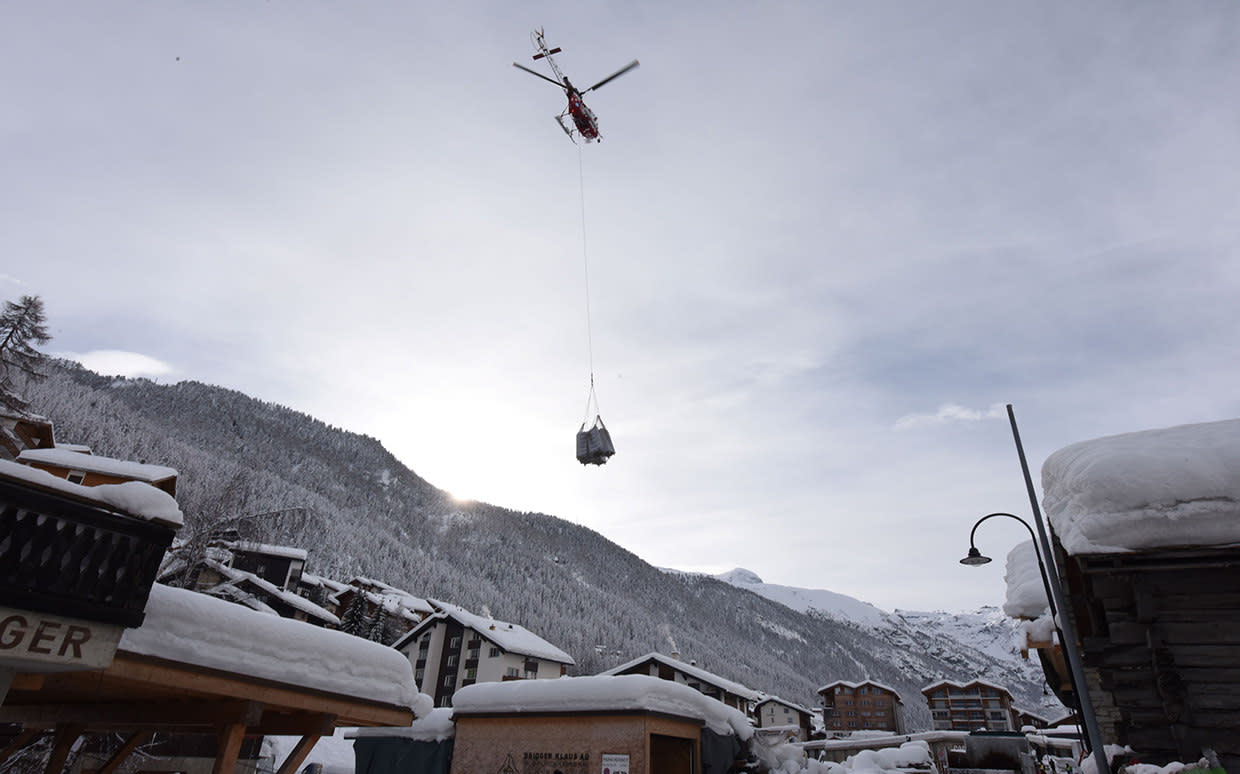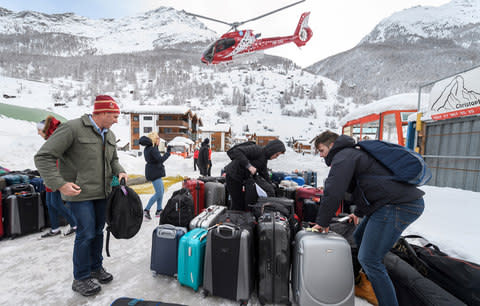Extreme weather in the Alps: everything you need to know

The past week has seen a rollercoaster of wild weather hit the Alps. Holidaymakers in ski resorts across the western and southern Alps, in particular France and Switzerland, have been stranded in villages or stuck on roads as heavy snowfall and a high avalanche risk makes travel - let alone skiing - nearly impossible.
The chic Swiss resort of Zermatt was among the worst hit, with an estimated 13,000 tourists becoming stranded when the rail line that provides access to the resort was closed due to the extreme conditions and a level five avalanche risk. By Tuesday emergency helicopters were airlifting people who urgently needed to leave Zermatt to the nearby village of Täsch, where rail replacement buses were in operation.
How bad is the situation?
Many skiers and snowboarders in the mountains are reporting unprecedented conditions across the Alps. Zermatt alone reported 200cm of new snow in 36 hours over Sunday and Monday.
The adverse weather has caused the avalanche risk in Zermatt and the surrounding area to reach its maximum level (five out of five) for the first time since 2009, according the the Institute for Snow and Avalanche Research (SLF).
Avalanche safety | Risk scale
No houses have been evacuated and those in Zermatt are free to move around the village. However, the authorities are monitoring the situation every half hour and there was believed to be a possibility of power cuts late on Tuesday.
The avalanche danger rating has remained between four and five for the past few days in a number of resorts in the Alps. “This is because temperatures above seasonal norms have been accompanied by rain below altitudes of around 2,200m to 1,800m, and wild and windy weather accompanying the precipitation means any fresh snow that has fallen at higher altitudes will be extremely wind-affected,” said Henry Schniewind, from Henry’s Avalanche Talk, of the situation in the Savoie region that includes resorts like Val d'Isère and Courchevel.
Large #avalanche between Täsch and Zermatt (Switzerland) this morning! Watch until 50 seconds! Our avalanche radar has detected all 45 avalanches correctly. The road has been closed for a while and nobody got hurt.
More about this system: https://t.co/Y6bmdAujZQpic.twitter.com/XqA4t1ev5Z— GEOPRAEVENT AG (@geopraevent) January 4, 2018
Relief is on its way as the snowfall in many resorts is set to ease and sunshine return, but it will take a number of days for resorts to get back to normal and re-open all roads and pistes that have been at risk of avalanches.
What is the current situation in Zermatt?
“We are working hard to get snow off the railway,” said Christian Ziörjen, director at Zermatt Tourism. It’s hoped that the resort will be able to reopen the access route on Wednesday afternoon or evening.

“The forecast ahead is a mixture of sunshine and cloud – as I look out my window now there is a lot of snow and blue skies,” continued Ziörjen.
People are now able to leave Zermatt via helicopter at a cost of 70CHF, with a current wait of an hour and a half. But with the main transfer days for holidaymakers not until the weekend many are choosing to remain and enjoy the snowy conditions, despite the majority of the ski area not being open due to the avalanche risk.

“There are fewer people wanting to leave now. Those that are here have been able to stay in their hotels, enjoy the cosy setting and look forward to a great weekend of skiing,” said Ziörjen.
“It’s very much a gilded cage,” said Edward Mannix, from Matterhorn Chalets, based in Zermatt. “Unless you actually want to go somewhere, which many don’t, there’s no issue. The sun is now shining and the wine is still flowing – the biggest frustration is that there isn’t much skiing.”

Operations to artificially trigger avalanches to make areas safe went on throughout Tuesday and are due to continue today, as weather conditions are expected to improve.
Which other resorts are affected?
The majority of resorts in the Alps have been affected by the storms over the past week, but the southern and western Alps have been the worst hit.
Closest to Zermatt, Saas-Fee, in the neighbouring valley, has had road access blocked from the village of Stalden. An estimated 1,800 tourists are currently staying in Saas valley and it is hoped that the road will reopen later today. The snow has also blocked access to other villages in the Valais regions of Switzerland, including Arolla, Visperterminen and Simplon village. The village of Gondo on the Swiss-Italian border is also cut off due to a mudslide on Monday.
Avalanche safety: How to stay safe from avalanches when skiing
Reports of road and piste closures have also come in from French resorts such as Tignes and Val d’Isère, which saw 100cm of snow in 24 hours between Sunday and Monday. The road to the hamlet of Le Fornet above Val d’Isère was closed for two days, access to the Tignes Val Claret and Le Lac was also limited and the main road to Bourg St Maurice in the valley was shut for a short time.
Both towns operated a curfew to keeps guests safe. In Val d’Isère visitors weren’t allowed outside between 10pm and 7am on Monday night and almost all lifts in the shared ski area remained closed on both Sunday and Monday.

The Trois Vallées resorts, including Courchevel, Méribel and Val Thorens, also had a level five avalanche risk at the end of last week, and although lower local slopes were open, inter-valley connections were closed for safety reasons. Similarly, the cable-car link between Les Arcs and La Plagne was closed all day on Thursday, with a limited service on other lifts in the ski area. Other resorts forced to close their ski areas included Alpe d’Huez, Avoriaz and the entire 4 Valleys ski area that includes Verbier in Switzerland.
What's the forecast?
“The forecast for the Alps seems to be mostly settled for the next few days with just occasional snow showers and plenty of bright spells to the end of the weekend. Freezing levels typically staying below resort level, so resorts will get a chance to clear up access roads but huge work is required to secure pistes,” said Paul Wisely from myweather2.com.
A further 46cm of snow is predicted in the snow report for Zermatt in the next seven days, with temperatures in the resort remaining well below 0ºC, but with a lull in snowfall over the weekend this will hopefully allow organisers chance to begin the clear up and tourists to make their way safely home.
Ski: the latest snow reports
What are your rights if your ski holiday is disrupted by heavy snow?
Check that there is a ‘loss of use’ clause in your winter-sports insurance documents. This covers days when you cannot use your lift pass due to bad weather, illness or injury. Usually this comes in the form of a monetary amount per day lost.
If you can’t ski or snowboard due to lack of snow, too much snow, high wind or risk of avalanche you should be able to claim on insurance, but check your policy wording. You may find that a high percentage or all the ski lifts and ski schools have to be closed before the insurance pays out. Tour operators and lift companies may also transfer you to an alternative resort.
Some insurers waive this type of cover when a policy is bought within 14 days of departure, as the conditions may already be predicted to be poor.

